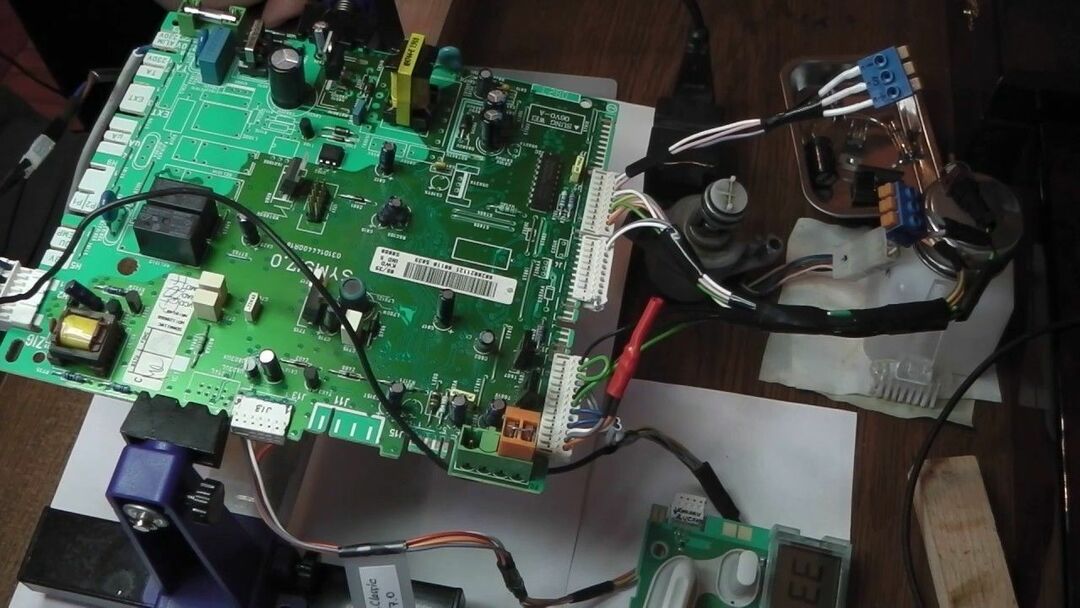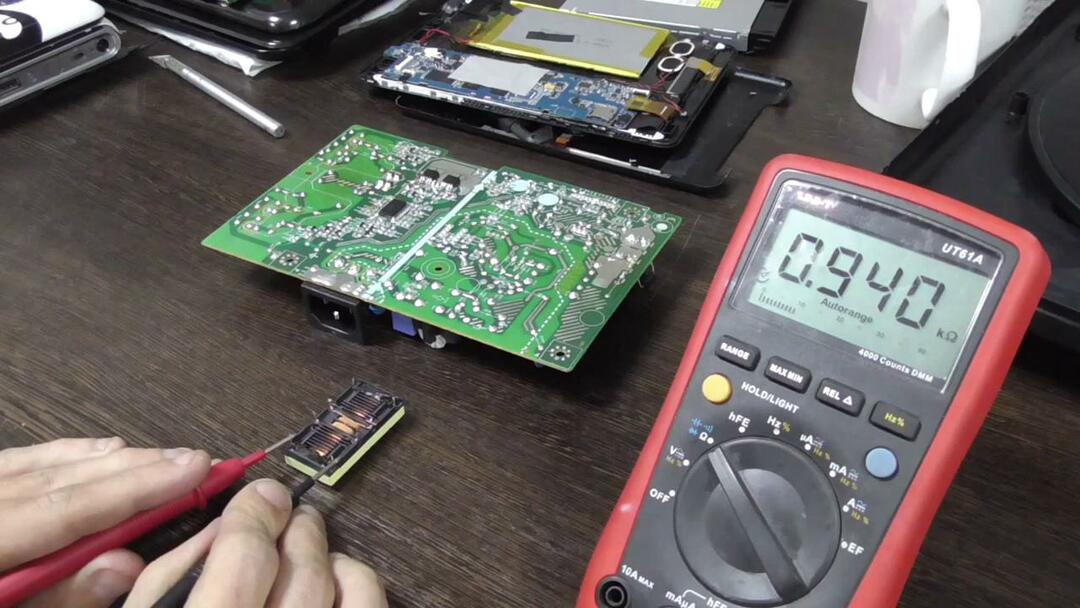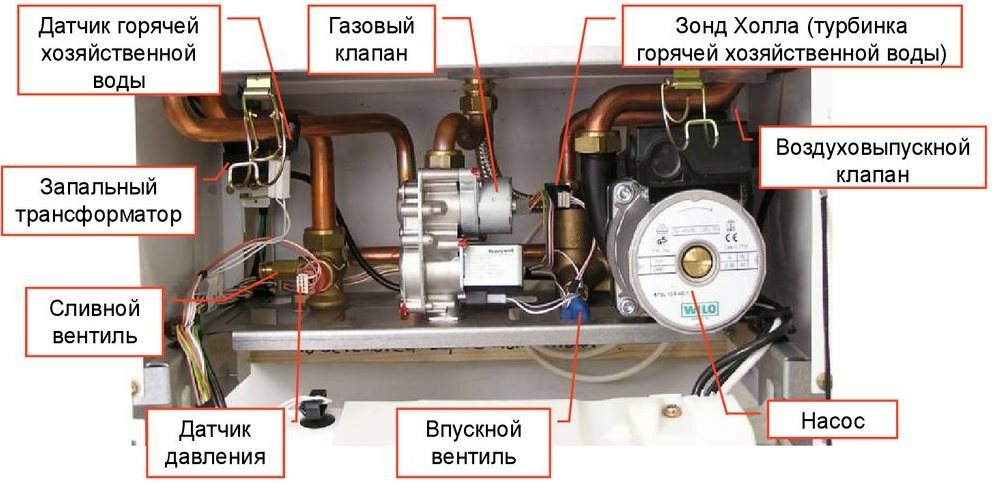The main purpose of domestic gas boilers is to provide housing with heating and hot water. The installation of such equipment cannot be carried out independently, since the installation work and the operation of gas appliances are associated with certain risks.
However, the owner of the house is directly involved in the design of the boiler room, the layout of the heating circuit, etc. To be able to to control the performers, it is necessary to understand how the unit works, what is the scheme of connecting the double-circuit gas boiler to the central gas pipeline and cylinders with blue fuel.
Answers to these questions are detailed in the article. In addition, we identified the technical requirements that are important to comply with in the design process of tying the boiler, its installation and use of gas equipment.
The content of the article:
-
How do double-circuit gas boilers
- Schematic of the heating circuit of the boiler
- The operation of the DHW circuit
-
Natural gas connection
- The method of connection with the gas line
- Technical nuances of connection
- Use flexible hose
- Features connection with cylinders
- Conclusions and useful video on the topic
How do double-circuit gas boilers
As a rule, gas appliances are installed under the heating closed type systemwhere the value of water pressure is not higher than 0.3 MPa. If we talk about how to properly connect the home gas boiler, the answer is obvious.
The scheme of artificial circulation of a coolant with an expansion vessel is traditionally used. To prepare hot water with gas equipment, centralized supply of cold-water is used with a pressure of 0.02–1.0 MPa.

The gas device established in the private house according to the scheme of double-circuit functioning. Such systems are widely used in suburban housing projects, as well as in urban private buildings.
True, the exact values are determined by the specific brand of equipment and manufacturer. Choice of a double-circuit boiler it is made taking into account specific conditions of installation.
Schematic of the heating circuit of the boiler
The heating circuit of the gas boiler by default is designed for filling the cold-water supply of the central water supply system. It is also allowed to operate heating equipment when water with glycol-based antifreeze is used as the coolant (C2H4(Oh)2), certified according to GOST.

Structural schematic of the operation of equipment designed to work with two circuits. With one (centralized) cold water inlet, effective heating and hot water supply is ensured for residential and other premises (+)
The coolant coming from the return line of the heating circuit is sent through a filter to the heat exchanger, the design of which provides the possibility of the initial filling and periodic feeding of the heating circuit with centralized water plumbing.
Further movement of the coolant activates the circulation pump, the design of which contains an automatic air outlet. Then the water flow passes through the zone of the minimum coolant flow sensor and is fed to the input of the first (external) circuit of the coaxial type heat exchanger.
Moving through the heat exchanger, the water is heated by the energy of the combustion gas.

The internal contents of a two-circuit gas system are built from a set of the following components: combustion chamber (closed type), heat exchanger, gas burner, circulation pump, heat exchanger (+)
At the exit of the heat exchanger, in the pipeline supplying the coolant, is immersed temperature sensor. It is also mounted safety valve spring action, equipped with a pressure relief mechanism.
The upper opening limit of the safety device is 0.3 MPa. The supply line also includes a membrane expansion tank.
The operation of the DHW circuit
The scheme of hot water supply works like this: cold tap water under the pressure of a centralized water supply system is fed through a screen filter to the water unit. The design of the unit, made of brass, provides the possibility of initial filling and periodic feeding of the DHW system.

Appearance of domestic equipment of water heating from gas with closed and open case. This is one of the most common constructions of gas boilers for domestic use, which are used in private households (+)
Further, through the installation area of the water flow sensor and through the magnetic anti-scale device, water enters the internal channel of a coaxial heat exchanger made of copper. Due to the selection of heat from the walls of the heat exchanger heated by the coolant passing inside the heating circuit, the cold water is heated.
The mode of preparation of hot water provides for a temporary shutdown of the boiler circulation pump. At the outlet of the heat exchanger is immersed temperature sensor, which removes the operating parameters of the supply line.
Here, on the boiler supply line, a second spring-loaded safety valve with a pressure relief mechanism is installed. The response limit is usually 1.0 - 1.1 MPa.
Natural gas connection
Gas boiler is designed to connect natural gas, the technical characteristics of which correspond to GOST 5542. Fuel, as a rule, is supplied from a low-pressure gas pipeline with a size of 0.0013 - 0.0020 MPa. A filter mesh and a flare ignition control valve are installed on the supply line.

The classic connection option, typical of most gas equipment designs with two working circuits. As shown in the photo, polypropylene pipelines were used as main pipelines.
The electromagnetic gas valve maintains the stability of the gas pressure at the inlet to the burner mechanism of the boiler. Therefore, regardless of gas pressure fluctuations on the line, stable, safe functionality with high efficiency is ensured.
The electronic control adjusts the power of the gas burner within 40-100% of the declared nominal power.
The method of connection with the gas line
Before considering the options for connecting natural gas to the boiler, it should be reminded of the established rules for the operation of such equipment. Gas boilers are technological objects of increased danger.
Installation, connection and operation of such systems requires compliance with established safety standards.

An example of the correct installation of the heating system and hot water when the equipment is installed in a separate room that has the status of auxiliary. Installation of such equipment, in accordance with all rules and regulations, suggests exactly this approach.
Gas boilers are mounted only inside the premises suitable for installation (kitchens, hallways, utility rooms). This refers to the premises of public production buildings, private houses, cottages. All of these properties must comply with the requirements for the presence of effective ventilation.
As a rule, compliance is determined by SNiP 42-01-2002 and SNiP 2.04.08-87. Solving the problem of how to connect the boiler to the gas line, you need to remember that the operation of the equipment requires the construction of a mechanism removal of smoke into the atmosphere. In addition, it is necessary to ensure the supply of atmospheric air for an efficient combustion process.

Connecting the installation involves several points of different purpose - gas, water, air. Each node is connected in accordance with the established standards, as well as according to the instructions of the equipment manufacturer.
Gas-fired boilers that support the function of the natural discharge of combustion products are to be installed in close proximity to natural flue chimneys.
For equipment, the design of which involves the intake of air directly at the place of installation, it is necessary to ensure a normal level of air discharge. Inside such premises, the air must be free from dust and chemical impurities.
Technical nuances of connection
The process of connecting the gas boiler to the gas pipeline with a flexible hose accompanies its technological and technical features. Thus, the laying of a gas pipeline and the subsequent connection with a boiler are permissible only for gas specialists.

Work on the gas pipeline and actions aimed at connecting the gas are coordinated with the organizations responsible for the operation of gas systems. In addition, the work on gas lines is allowed only to specialists gas specialists. All statements about the possible self-connection are unsubstantiated.
Before connecting the gas boiler, clean the supplied section of the pipeline from third-party substances, impurities, and impurities. This requirement is particularly relevant for installation on used systems.
The gas inlet must be equipped with shut-off valves designed for operation in the gaseous medium, supplemented with a thermal blocking device (TAE). Before connecting the gas pipeline to the boiler, it is necessary to check the tightness of all connections and gas pipe connections with a test pressure of at least 0.15 ATI.
The flue gas cross-section should correspond to the diameter of the nozzle on the flow protection device. Narrowing of the entrance part of the flue gas pipe is allowed, but only if it is justified by calculations (according to GOST standards) of the correct functioning of the line.
Pipeline exhaust gases do shortened (if possible), with some bias in the ascent to the chimney.

Checking gas connections for tightness is a procedure that is mandatory in the case of installation, connection to the gas main and boiler operation. Only after successful verification is it permissible to run the equipment into operation.
The gas supply line to the boiler is usually made on the basis of a metal pipe. It is allowed to construct supply lines on the basis of steel and copper pipes.
Meanwhile, the permitted installation of plastic pipes (multilayer, with a metallized layer) is also not excluded. However, polymers are allowed to be used only inside buildings with a height of no more than three floors.
Use flexible hose
It is acceptable to connect the gas source to the boiler using flexible hose.
Condition for use of flexible hose:
- resistance to the gas environment;
- compliance with the working (test) pressure;
- compliance with the working (test) temperature.
The noted characteristics and parameters can be taken from the technical passport of the boiler equipment. In this case, the flexible hose used must have a diameter size of 20 mm and the length of the sleeve may not exceed 1.5 m.

An example of the connection of the gas line equipment with the central line with a flexible hose. In such cases, special sleeves are used, which from all others primarily differ in characteristic color. Gas hoses are designed for high pressures and temperatures.
Connection by flexible hoses (sleeves) must be performed in full compliance with the installation rules specified in the accompanying documentation of the product manufacturer.
Features connection with cylinders
Flexible hoses (sleeves) are often connected SG cylinders with boiler installation. However, to turn on the boiler in just such a fueling mode, it is necessary to perform a number of settings for switching equipment to operation with bottled gas.
If the design of the boiler supports a similar power option, the instruction describes the sequence of operations.
Here, the technological requirements imposed on the sleeves of a flexible structure do not practically differ from the requirements for connecting to a centralized highway. Also, the diameter of the sleeve is not less than 20 mm with a length not exceeding 1.5 m. However, the gas cylinder should be equipped gearboxtuned to a pressure of 2.9 kPa (steam environment).

An example of an unacceptable installation of a gas heating system, when liquefied gas cylinders are placed near the equipment. This connection option is contrary to existing rules. Cylinders are always located in a separate area, outside the premises.
For cases of feeding boilers with bottled liquefied gas, separate standards have been approved, in particular, related to the storage and operation of cylinders. For example, these standards do not allow vessels to be placed in open areas of the sun, near heat sources and open flames.
One of the main prohibitions is the taboo on the installation of gas equipment directly inside buildings.
An overview of gas boilers running on liquefied bottled gas is given in this article.
Thus, the use of gas boilers in practice, including the domestic sphere, should be considered responsible for the action, the accuracy of which determines the degree of safety.
Conclusions and useful video on the topic
A few helpful gas boiler installation tips will help you verify proper installation of the equipment.
With all the perfection of gas equipment, in the presence of automation and serious technological protection, connecting the system requires compliance with established rules and regulations. Without this, it is impossible to guarantee the reliability of gas boilers.
Is there anything to supplement, or have you had any questions regarding the connection of a double-circuit gas boiler? You can leave comments on the publication and participate in discussions of the material presented. The block for feedback is below.


